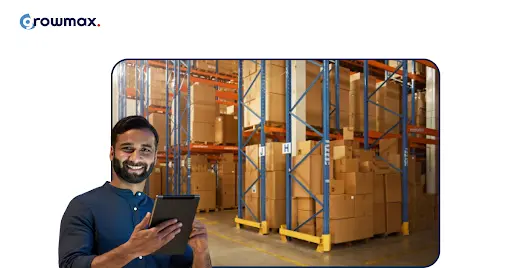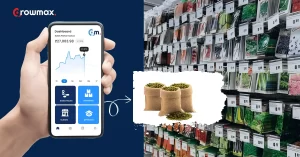Do you know that 77 percent of businesses experience inventory errors due to manual processes, according to a study by Capgemini, and 34 percent are more expensive than those using automated systems, according to Aberdeen Group?
On the other hand, companies using auto stock replenishment systems experience a 30 percent reduction in inventory costs and a 25 percent increase in inventory turnover.
Brands must comprehend that customers dislike waiting to purchase their favorite products, making them go for the other best alternatives. If they don’t want their customers to flee away due to bad experiences, they have to make some significant modifications at the inventory management level.
If brands need more stock, how could they meet customer demand? Similarly, how could they bear unnecessary costs if they have excess stock?
Challenges brands endure with the issues of manual stock replenishment.
It takes hours or even days for brands to manually refill their shelves with stocks to ensure that “supply doesn’t fail to fulfill demand”. Brands want to retain their potential customers due to inventory mismanagement, as usual, when consumer goods brands manage their inventory manually.
No access to an actual inventory position
Brands still need to be stuck into the old and manual methods of tracking and monitoring their inventory, which makes them unconscious and clueless about the real-time availability of their stock, leading to uninformed decision-making.
Every brand wants to track the fluctuations in their inventory level in real-time, but they need to be aware of tech-driven evolutions.
The major problem for brands pops up when they have to make purchasing-related decisions based on manually generated inventory-level insights, leading to over-ordering or under-ordering.
Dependency on Inefficient Techniques
How hectic and monotonous it is to count stock physically and then manually update data in a spreadsheet to generate reports, making brands’ valuable time waste away as the brand’s entire journey of getting rid of stock level problems is filled with picking and packing errors and delay in order processing.
It becomes a pain in the neck as brands don’t have a proper system or tool to look into the accessibility of non-perishable products to take orders from customers instantly. If anything goes wrong, it will directly hamper their image in the market.
Needs to be more efficient in operations, costly errors, and not matching consumer demands on time. These issues arise when brands place orders manually (in case of reorder point).
Insignificant surge in operational cost
If consumer goods brands have humans managing their inventory level, there is a high probability of incurable errors like incorrect counts, misplaced items, and inaccurate data entry. Which ultimately leads to overstocking or understocking bottlenecks.
The overstocking problem leads to the inability to make informed decisions, triggering high storage costs, risk of obsolescence, and high insurance premiums.
Stockout directly affects the foundation of consumer goods brands, i.e. sales/revenue. Instead, 62 percent of customers find a different brand than wait for an out-of-stock item, according to Statista.
Missing competitive advantage
The Biggest bottleneck of any consumer goods brand is making the right decisions at the right time to remain competitive.
The inaccessibility to real-time visibility, inefficient inventory management, risk of overstock and stockout, and lack of data-driven decisions break apart that edge brands would have capitalized on.
Also Read : FMCG Distribution: Why You Need a DMS Software
How does auto stock replenishment work?
To put it in simple terms, predicting the accurate number of stocks required on shelves by analyzing the historical sales data with the help of AI algorithms.
The system takes over all the manual efforts in inventory management tasks like determining the optimum inventory to purchase from suppliers, running daily sales rates, calculating supplier lead time, and processing data to produce results. So brands can focus on their business.
Auto stock replenishment (ARS) ultimately ensures brands have the right stock at the right time to meet customer demand by analyzing the inventory level and reorder level of brands in real-world time.
What are the benefits of onboarding an auto stock replenishment system to consumer goods brands?
I want brands to have a closer look at how ASR can drastically transform their process of inventory management, specifically the refilling part, which not only helps them have an efficient operation but also gets ahead of the competition.
Improves efficiency and productivity
ARS automates the manual effort put into every single day in consumer goods businesses.
It saves precious time for employees assigned to look into the inventory level manually.
ARS algorithms place orders instantly and automatically, helping brands fulfill the real-time needs of customers.
Cuts down irrelevant cost
ASR lowers the risk of products expiring or becoming obsolete, preventing unnecessary costs from occurring.
Manually updating data in the spreadsheet as to the level of stock is no longer needed due to the advent of ARS.
ARS ensures lower lead time for quicker replenishment of stock, making businesses respond rapidly to changes in demand and supply.
Accurate recording
Real-time update of inventory level once products are received, sold, or moved within the warehouse, helping brands get a fair picture.
ARS automatically measures Order quantity, reorder point, and safety stock, eliminating human errors.
Free from stockout and understock
ARS can accurately forecast market demand to ensure sufficient stock and avoid customer disappointment.
Now, bands don’t have to suffer owing to the issue of overstock and the possibility of product return as ASR cuts down any risk associated with that.
Customer satisfaction
ARS helps brands tailor their customer’s experience by just taking care of the inventory level. Customers only remember “how brands made them feel” while shopping.
Consistent product availability and efficient order fulfillment are the foundation of trust building between brands and customers which onboarding ARS ensures.
Concluding with a note
If you’re tired of monitoring your inventory levels manually, it’s time to consider implementing an automated stock replenishment system. This system can help you overcome the challenges that come with manual techniques and ensure efficient inventory management.
And remember to check out the auto-replenishment system by Growmaxbi




